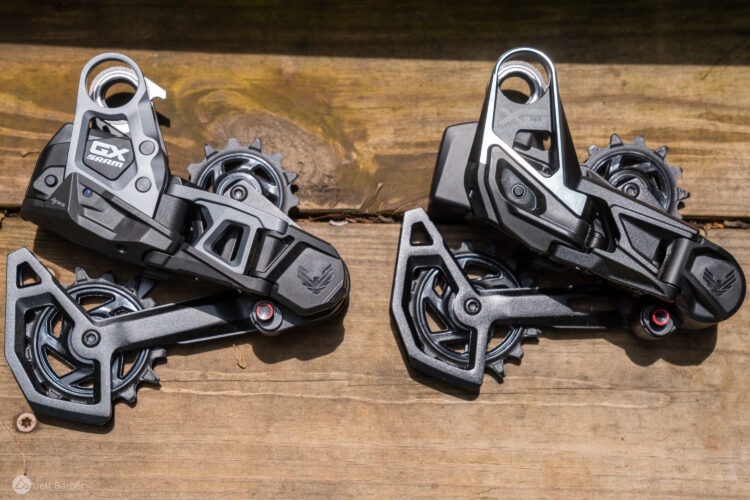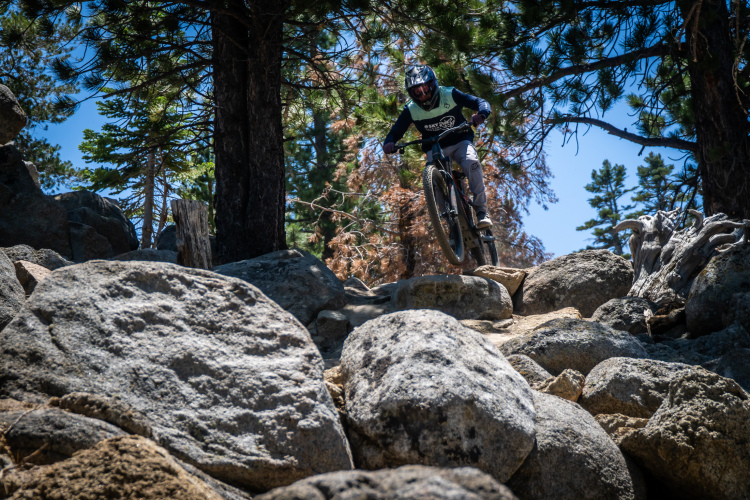
Lennard Zinn is a bike designer and frame builder based in Louisville, Colorado. His shop, Zinn Cycles, offers “a full line of semi-custom and off the shelf bikes for riders from very small to very tall and everyone in-between.” He’s also the author of Zinn and the Art of Mountain Bike Maintenance, one of the world’s best-selling guides to mountain bike repair.
In this first-half of our podcast discussion, Zinn talks about drivetrain maintenance, focusing on chains and lubrication. Later in the show we talk about the benefits of big 32-, 36-inch, and 750d bike wheels and designing bikes for riders both tall and small.
Drivetrains: chain wear and lubrication
Understanding bike chain wear and elongation0:00
- Chain wear is caused by dirt and oil-based lubricant sticking to the chain, creating a grinding paste that wears down the rollers, bushings, and pins.
- Zinn describes how the chain’s inner links are made with a bushing that forms when the plate is punched, and how the roller sits on these bushings.
- The chain’s flexibility increases as the bushings and plates wear, affecting shifting performance.
- A chain’s lateral stiffness is crucial for proper shifting, and a worn chain can cause skipping during shifting.
Chain elongation and its effects6:46
- Zinn discusses how a chain’s elongation affects its performance, particularly when the distance between rollers exceeds the half-inch standard.
- He explains that a worn chain can misshape the cassette’s teeth, leading to skipping and poor shifting.
- Chain checkers can be used to ensure the chain’s length is within spec to prevent cassette wear.
- Chains are much cheaper than cassettes.
- Host Jeff Barber shares a personal experience of replacing a chain only to find the cassette was worn out, emphasizing the importance of chain checkers.
Lubrication and its impact on chain wear22:35
- Zinn explains that a dry chain will wear faster due to friction, while lubrication helps reduce wear but can attract dirt.
- He discusses the differences between factory lube and other lubricants, noting that factory lube is designed for machinery, not for low friction on the bike.
- Zinn recommends using a cleaner to remove factory lube before applying chain lube.
- He introduces the concept of chain waxing, which involves immersing the chain in molten wax to create a low-friction, clean-running chain.
- Zinn shares the benefits of chain waxing, including reduced noise, lower friction, and longer chain life.
Chain waxing process and benefits35:43
- Zinn describes the process of chain waxing, including the need for a clean jar of mineral spirits and denatured alcohol for cleaning the chain.
- He explains the importance of articulating the chain during the waxing process to ensure all links are coated.
- Zinn highlights the advantages of chain waxing, such as reduced noise, lower friction, and longer chain life.
- He mentions the cost-effectiveness of chain waxing compared to replacing chains frequently.
- Barber shares his positive experience with a waxed chain, noting its quietness and efficiency.
Proportional frame design and component selection
Custom and semi-custom bikes for small and tall riders50:11
- Zinn discusses his involvement in custom bike brands Clydesdale for big and tall riders and Tui for smaller riders.
- He explains the history of Zinn Cycles, starting with mountain bikes in 1982 and evolving to road bikes and custom frames.
- Zinn shares the challenges of making high-quality bikes for women in the 1980s and 1990s, when most companies focused on men’s bikes.
- He describes the development of the Clydesdale line to provide unbreakable, high-quality bikes for big and tall riders.
- Zinn mentions the Tui line for smaller riders, aiming to fill the gap between high-end custom bikes and standard production bikes.
32- and 36-inch bike wheels (and 750d too)
Wheel sizes and their applications1:03:20
- Barber inquires about the use of 32-inch and 36-inch wheels, which Zinn explains were popularized by unicycle riders and beach cruisers.
- Zinn discusses the advantages of larger wheels for tall riders, noting that 32-inch wheels can make a bike look proportionally sized.
- “Maxxis is in the testing phase. They’re supposedly going to do a 32×2.25 inch tire.”
- He explains the challenges of using larger wheels, such as increased weight and the lack of suspension forks.
- Zinn mentions the development of new carbon rims and tires for larger wheels, which could improve their performance and weight.
- “With the Enve mountain fork, and then the 750d, there’s an Enve Adventure Fork that is a rigid carbon fork that’s quite a bit lighter than the mountain fork that makes for a really cool gravel bike with the 750d size for a tall person. That’s an awesome thing because the WTB 750d rims and tires are really nice and then with that fork, it’s not that much of a weight gain, but, boy, it rolls over anything, you know, where you can take a gravel bike on some pretty rough trails and because of that same thing that we all saw when we went from 26 inch to 29 inch, where we could just roll over a bunch of stuff with a rigid bike that you would have to have suspension of the 26 or to do that’s that’s happening too.”
- Barber asks about the feasibility of using suspension forks with larger wheels, and Zinn confirms that rigid forks are the only option.
Bike design challenges and geometry trends
Challenges in designing bikes for small riders1:16:58
- Barber asks about the challenges of scaling bikes for smaller riders, and Zinn explains the limitations due to the need for certain components.
- Zinn highlights the importance of proportional design, where larger wheels can make a bike look more proportionate for tall riders.
- He discusses the ergonomic issues for small riders, such as wider Q-factors and shorter steerer tubes on forks.
- Zinn mentions the UCI’s weight limit in road racing as an example of how smaller riders are often disadvantaged.
- He emphasizes the need for designers to consider the specific needs of smaller and taller riders in their designs.
Modern trends in bike design and their impact1:18:46
- Barber asks about modern trends in bike design that may not be beneficial for all riders, and Zinn highlights the shortening of steerer tubes on forks.
- Zinn explains that shorter steerer tubes are often used to accommodate longer travel forks, which can be problematic for tall riders.
- He discusses the trend of wider rear ends in modern bikes, which can be detrimental to smaller riders due to increased Q-factor.
- Zinn mentions the importance of considering the needs of all riders, not just those who are average in size.
- He emphasizes the need for designers to balance performance and ergonomics to create bikes that are accessible to a wider range of riders.
Find out more about the chain waxing service and bikes discussed in this episode at zinncycles.com.
Support this Podcast
- Review the Singletracks podcast on Apple Podcasts or drop your feedback in the comments below!
- Make a donation to help sustain future episodes.
- Become a Singletracks Pro Supporter.
Never Miss an Episode
- Listen on Spotify
- Listen on Apple Podcasts
- Listen on Google Podcasts
- Listen on Stitcher
- Listen on Overcast
- Get the RSS Feed
- View all Podcast Episodes











7 Comments
Oct 1, 2024
Oct 1, 2024
Oct 1, 2024
Oct 3, 2024
I clean my new chains & use a good quality oil. I am not interested in keeping up with all the latest 12 or 13 speed cassettes so my consumable costs remain reasonable.
Oct 2, 2024
Oct 3, 2024
I'm surprised how well the immersion-waxed chain is holding up, but time will tell. Not sure I'll get 1,000 miles out of it but I definitely would have needed to re-lube at this point with my usual stuff.
Oct 4, 2024